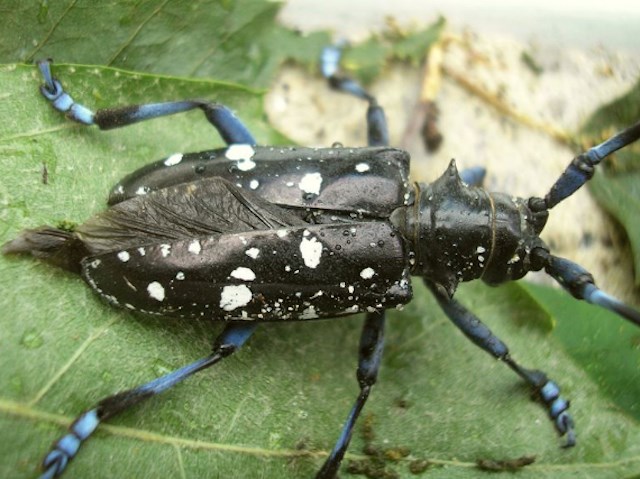It looks like a Sawyer Beetle on steroids.
The Asian Long-Horned Beetle is 30 millimetres long, antenna to posterior, and resembles a larger cousin of the Sawyer Beetle which many Canadians are familiar with.
The invader's larvae are the girth of a woman's thumb. The insect originated in China and Korea and is thought to have migrated to Canada and the United States likely via shipping materials accompanying imported goods.
The holes Asian Long-Horned beetles leave in our trees, often Norway Maples, are nearly the diameter of a 10 cent coin and can be easily be seen with a pair of binoculars if you look up at a tree from the ground.
The tree will eventually die because the insect's boring destroys its ability to conduct water in its trunk.
Dr. Amanda Roe, a scientist at the Great Lakes Forestry Centre in Sault Ste. Marie says it took years to eradicate an infestation of the Asian Long-Horned Beetle in Toronto and Mississauga.
First detected in Ontario around 2003, the infestation was put to an end in 2020. The only known fix is to cut down affected trees and then to observe adjacent trees for several years to make the insect hasn't spread.
Research is ongoing but Dr. Roe and her colleagues at Natural Resources Canada’s Great Lakes Forestry Centre are hopeful for the future. She's been working on this project for more than four years.
She said, "Science tends to be a bit of a long haul so it's nice when you pull things together into a story.
"That's what's always appealed to me is just learning something new and telling a story with it.
"We're actually almost overwhelmed by the information that's in the genome. It's whether we can comb through the Information and put together the pieces. We can trace things back to their origins because everything has to come out of the native range at some point," concluded Dr. Roe.
Experts from across North America gathered virtually recently to discuss insects and diseases that threaten our forests.
Organized by Natural Resources Canada, the Forest Pest Management Forum Feb.16 and 17, was the largest and most significant gathering of forest pest management experts, managers and practitioners in Canada.
Dr. Roe presented a paper on Tracing the Asian Long-Horned Beetle through genomics.
She's a research scientist, Insect Production and Quarantine, at the Centre.
The Asian Long-Horned beetle prefers to eat maples and threaten Canada’s eastern forests. Canada’s maple syrup producers will soon harvest and produce maple syrup, a $558M industry last year.
The Asian Long-Horned beetle is a serious threat but research findings are hopeful.
Natural Resources Canada, the Canadian Food Inspection Agency (CFIA) and other partners successfully eradicated the beetle in Toronto and Mississauga in 2020.
However, the threat of new invasions continues, with a recent outbreak in Edmonton and new infestations in the United States. The risk of spread into Canada’s forests still exists, so surveillance is key.
For this, scientists need citizen help.
Dr. Roe is using genetics to predict how the beetle got to Canada. She wondered if it arrived from its native range, or through secondary spread from the USA or Europe.
She is developing rapid-screening tools to trace how new arrivals enter Canada to help Canada improve its surveillance and monitoring for high risk imports as well as countries of origin.
Along with that, Dr. Roe is studying how the beetle can withstand cold temperatures, which it does in its native range of northern and central China.
She says Canadians can help fight the Asian Long-Horned Beetle by not hauling firewood from one area to another.
To report a potential invasive species sighting, please click here.
